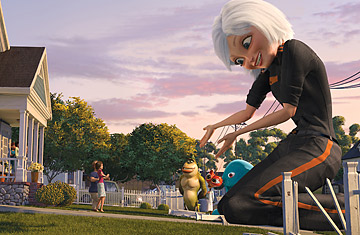
Monsters vs. Aliens
You saw the 3-D Monsters vs Aliens commercial during the Super Bowl — maybe with the special glasses or, without them, as a myopic blur. If you took your kids to the Jonas Brothers movie, you sat through nearly a dozen trailers for 3-D movies to be released this year. Perhaps you saw the latest issues of TIME, People and three other Time Inc. publications promoting 3-D as "pretty darn cool," and citing such top directors as Steven Spielberg, James Cameron and Peter Jackson as being in love with the process.
One way or another, you've heard that 3-D is the Next Big Thing — as important a change, says its most assiduous cheerleader, Jeffrey Katzenberg of the DreamWorks animation studio, as sound (which revolutionized movies within three years in the 1920s) and color (introduced around the same time, and ubiquitous from the mid-'60s). As a TIME story trumpeted in 1990, the last time the revolution was proclaimed: "Grab Your Goggles, 3-D Is Back!" (See the top 10 movie gimmicks.)
No question that 3-D has an appeal to an industry that, though the box office has been robust in these recession days, is facing a slump in DVD sales and the prospect of hard times. Monsters vs Aliens, which opened Friday, is bound to be the weekend's big picture. Cameron's 3-D Avatar, his first feature film since Titanic in 1997, is the gotta-see event of 2009; and any film in the process by Spielberg, Jackson, Robert Zemeckis or Robert Rodriguez should be exciting, if only because the directors will be juiced playing with this marvelous toy. But can the format transcend its status as an event, or a gimmick, and become the way most people see most movies? Is three automatically better than two? That remains to be proved.
"A Lion in Your Lap!"
Experiments in depth simulation go back to the first years of movies. At the end of the 19th century, British inventor William Friese-Greene secured a patent for a 3-D movie process. In 1915 Edwin S. Porter, whose The Great Train Robbery had stoked the first great movie sensation a dozen years before, presented a series of 3-D documentary shorts to a New York City audience, who viewed the short documentaries through anaglyph (red-green) glasses. In the 1920s, many 3-D shorts appeared on programs at theaters such as New York's Roxy. MGM presented three 3-D talkie shorts from 1936 to 1941, the last one in Technicolor. The Polaroid filters created by Edwin Land were used for a short shown at the Chrysler Pavilion of the 1939 New York World's Fair.
Now Is the Time to Put on Your Glasses: that was the title of a short film made by the renowned avant-garde animator Norman McLaren for the National Film Board of Canada in 1951. It was also the cue for moviegoers the following year, when Bwana Devil, Arch Oboler's low-budget safari epic, introduced 3-D to the postwar audience. "A Lion in Your Lap! A Lover in Your Arms!" the ads read, but the big thrill was a native's spear tossed into the audience. The picture found an audience, and instantly theaters were flooded with 3-D movies — more than 100 features and shorts in the next two years. Though the most famous ones were in the genres of horror (House of Wax, Creature from the Black Lagoon) and science fiction (It Came from Outer Space), the format also attracted A-list directors. The Vincente Minnelli musical Kiss Me Kate was shot in 3-D, as was Alfred Hitchcock's Dial 'M' for Murder.
Exhibitors had to pay for the double projectors, but they ponied up eagerly, for their business, their very existence, was threatened by another technological marvel — TV — that was keeping customers at home, getting drama, variety shows and old films for free. Movie houses were turned into video amusement parks: the image on the giant screens was suddenly wider (CinemaScope), grander (Cinerama), clearer (VistaVision) and deeper (3D) than ever before. The idea was to lure people back to theaters by giving them an experience that couldn't be duplicated in the living room. It didn't work: the number of tickets sold dropped from an all-time high of 4 billion in 1946 to about a billion a decade later. And though the wide-screen process stuck, 3-D disappeared within a few years; many films shot in the process were released in "flat" versions.
Every couple of decades thereafter, 3-D would make a comeback. The lightweight sex comedy The Stewardesses, filmed in single-strip Stereovision, was a hit in 1970; and the first hardcore 3-D movie, The Starlets, came out in 1977. (I leave the stereoptical effects of this picture to the reader's imagination.) The 1983 Jaws 3-D, utilizing a single-camera process called Arrivision, was an example of several horror series whose third episode was in 3-D (Friday the 13rd Part 3, Amityville 3-D). That 1990 TIME story was heralding a liquid-crystal technology called IMAX Solido. Since then, IMAX had become a reliable adjunct to the movie-theater business, both in its own documentaries and in special versions of movies like The Polar Express and The Dark Knight; but it accounts for only a small part of movie ticket sales.
